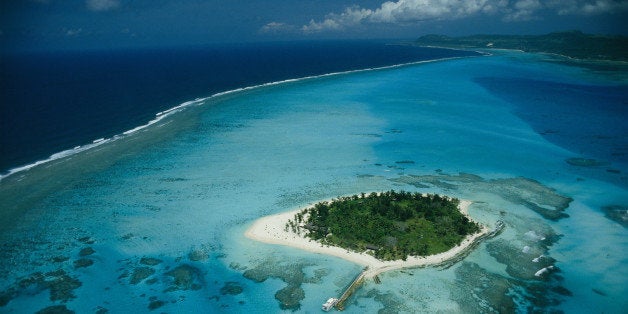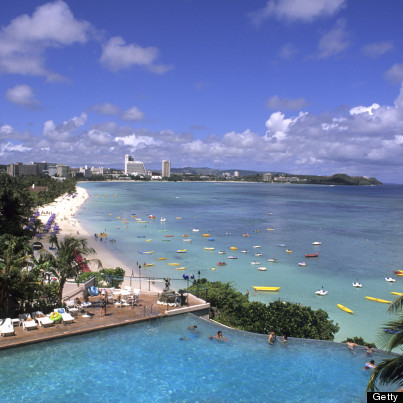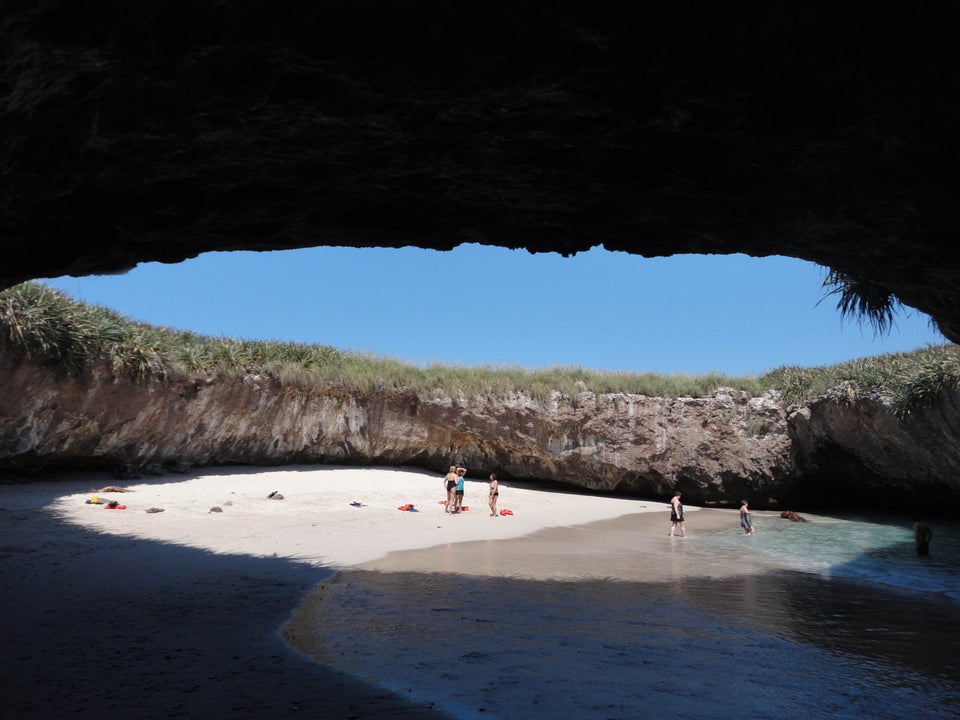
Don't hate me, but about 12 years ago, I left a well-paying lawyer job in New York to move to a small tropical island near Guam. I had five weeks paid vacation, mango and banana trees in my yard and went scuba diving nearly every weekend.
I'd like to say it was some sort of insight about the Meaning Of Life or a sudden urge to commune with fish that got me moving. In reality, it was a terrific combination of terrible things in the romance, personal well-being and employment departments that left me wanting to flee the city -- and fast.
And as it happened in November/December of 2001, the moment these terrible things were all converging, I just lucked out: The person who'd been hired for the job I was eventually offered on the island -- a lawyer with the local Supreme Court -- was disbarred. Since she was no longer eligible (at least that's what the court's HR person told me), she was out, and I was on my way to Saipan, Micronesia's second-most-populated island. (Guam's the first. More on that in a bit.)
I went to Saipan intending to enjoy my tropical paradise for one year. One year, I figured, would be enough to heal from my various personal traumas, plus come up with a brand new life plan, get a good tan and maybe even meet the man who'd prove to that other guy (in hindsight, a real asshole) he'd made a huge mistake leaving me for his secretary. As it turns out, there was a lot I didn't quite realize when I first embarked on this little journey of sun-exposure, self-discovery and revenge, which ended up lasting 5.5 years.
Here are a few things I understand now that I didn't have the slightest inkling about when I first set out on that long trip with far too much baggage:
1. There Is No Such Thing As Paradise
Things look simply great from a distance. Looking at a tropical island from afar, you see the pristine island surrounded by the blue, blue sea. Closer up, you learn that the blue, blue sea is contaminated with industrial runoff and sewage.
I believe this is a good metaphor. I also found it to be literally true that the fantasy about island living is partially accurate. I did spend a whole lot of time hanging around at the beach while I was living there, but it's a kick in the pants to learn that island life is still life, which means that it's still complicated. The politics are complicated, personal relationships are complicated, workplace dynamics are complicated, $150,000 in student loans don't magically disappear, public utilities can be pretty hit-or-miss and sometimes, your neighbor will let their goats graze in your yard and they eat all your bananas. (OK, the one about the goats is particular to island living. I think.)
It's just that at the end of the day on Saipan, I could go for a quick scuba jaunt with those complicated coworkers. I'd never been scuba diving before moving to the island. I found it to be the most meditative experience of my life -- all deep breathing and silent -- and a thrill to move through clear and warm, if distressingly polluted, water in that way while getting to know that magical marine world. So, yeah, that part really was fantastic.

2. Don't Go Parasailing (Or, You Can Move, But You'll Still Be You When You Get There)
Not all water-based experiences were so positive. A couple of weeks after moving to the island, I went parasailing with some new friends. Their friend, who owned the parasailing company, offered to let us go for free. It was a beautiful sunny day and the blue waters were calm and clear (except for the feces and industrial runoff).
The people handling our adventure seemed as calm as the lagoon. Which maybe they shouldn't have been, since when my friend Joe and I were up flying high, tandem in our harness, the rope snapped.
Obviously, we made it out alive, thanks to Joe's quick action of getting us out of that damn harness so we wouldn't be dragged under by the parachute, filling with water. But, in the boat afterwards, as Joe drank a beer and I sat rocking back and forth while clutching my knees to my chest, I had some insights.
First, that I would never, ever, ever go parasailing again, because even though it was spectacular to see our beautiful island while floating above the (contaminated) water like that, it wasn't spectacular enough to risk another rope-snapping. The other thing that stood out to me, once I'd stopped shaking, was how differently Joe and I reacted to the same incident. He was as unruffled as ever. And I was neurotic, because it turns out that I was still me, even on a gorgeous small island near Guam.
3. Great Things Come From Unexpected Places
I may have still been me, even on this small island near Guam. But the island was completely different from where I'd been, in both good and bad ways. Bad: No subway or other public transportation. Good: No winter. And the best spring rolls I ever ate in my life were served in the restaurant section of a small brothel in the island's main village. I think it's closed now -- both the restaurant and the brothel -- but if you ever get to Saipan, ask around for where to get great spring rolls. Someone will be able to point you toward a place you may not have expected (a lesson applicable to many things in life beyond spring rolls).
4. Guam Is a Hub of Civilization
When people ask, as they do not often enough, what is the biggest thing I discovered while living in Micronesia, I usually say "Guam."
Mainland Americans, if they think of Guam at all, usually use that island as shorthand for the end of the Earth. ("She's moving to Maryland? Why not Guam!")
But once you move to Micronesia, you come to think of Guam as being the big city -- Providence to Saipan's Warwick, to use a hometown comparison. And for good reason: It's got major military installations, a 24-hour Kmart, multiple Taco Bell outlets and roads long enough you could drive for two hours without circumnavigating the whole island. (And like many urban environments, there are pests -- in this case, bird-decimating snakes, targeted by a number of odd weapons, such as poisoned mice.)
It takes about an hour to fly to Guam from Saipan, and we used to go for the weekend sometimes just to drive for a while and enjoy the amenities (we never actually saw any snakes in person). Folks would fly back on the little puddle-jumpers carrying bags of Taco Bell for their hungry friends and relatives.
In other words, I came to see the world differently in ways I didn't expect, living in Saipan for 5.5 years. Guam is an example of that. And remind me to tell you sometime about the time my then-boyfriend and I almost drove our rental car onto the drag racing strip, which the car rental company representatives had explicitly told us not to do.

The big city of Guam
5. It's Hard Coming Back
My mother denies this, but I have clear memories of her calling me every week or so and saying on the phone, when the phone lines weren't down, "Why are you hurting me by being so far away? Why can't you just come home?"
After 5.5 years, it was time to move back to the mainland. I'd left for Saipan in my late 20s. Entering my mid-30s, with another long relationship ending and me thinking I was ready to give up law altogether (even if my law school loans weren't ready to quit me), I realized that even if I didn't quite feel ready to leave the island, even if the man who'd broken my heart back in New York still wasn't sorry, it was probably time to go. I was coming to an age where I might not want to keep moving every five years or so. I wanted to try making a more stable life for myself. Maybe. Anyway, given that this island where I'd stayed a lot longer than I'd expected to was a good 24-hour, $1,600 flight from my family, it seemed like I'd better skedaddle if I was ever going to leave.
But coming back without any more of a real plan than I'd left with was tough. Somehow -- but how? -- the friends and family I'd left behind hadn't just quit everything to wait for my return. They'd gotten married, had kids, become busy. I was single again, and didn't come home to find a job and an apartment and a bank account waiting for me, either. I came home and had to start over, with some new odd listings on my resume and the urge to drop observations about Guam and the rejuvenating powers of scuba diving and the tastiness of brothel-made spring rolls into every conversation. You can see how that might be alienating.
I've been in D.C. for a little over six years. I'm a writer now, instead of a lawyer, and I met my husband here. Instead of going diving after work, I walk our dog -- which isn't the same as seeing fish underwater, but it's also a kind of meditative, calming activity. We can go to Kmart whenever we want without having to fly, which may sound trivial -- but you'd be surprised how much you miss ordinary things when you don't have them. The tradeoffs seemed worth it and I'm glad I came back -- especially now, when my mother is having a health scare and I don't want to be a 24-hour flight away.
Of course there's a lot I still miss, even six and a half years later; it gets especially acute every year as the weather gets colder and my husband is vexed when I start asking him why, why we never go drag racing. But what's strange is that despite all my efforts trying not to forget the runoff in the lagoon, I can't quite tell anymore when I'm missing the the real place I left or if it's some idealized version of the complicated paradise that I'm thinking about instead.
A quick note about the island at the top of this story. It's called Managaha, and it's a short ferry ride away from Saipan, which you can't actually see in the picture there. Saipan is about 44 square miles, and has beaches but also jungle, villages and a tall hill in the middle, while Managaha really is tiny and ringed with a white sand beach. No one lives there; it's a place to go snorkeling for the day and if you're very outdoorsy, maybe to camp out overnight. Managaha is also home to the burial site of a famous chief (if you ever get the chance, learn more about the long-distance Micronesian canoers), World War II artifacts and a wide variety of medicinal plants. So, even there, there's more than immediately meets the eye. But what meets the eye is also pretty terrific.
This post is part of a series produced by The Huffington Post in conjunction with our women's conference, "The Third Metric: Redefining Success Beyond Money & Power," which took place in New York on June 6, 2013. To read all of the posts in the series and learn more about the conference, click here. Join the conversation on Twitter #ThirdMetric.

